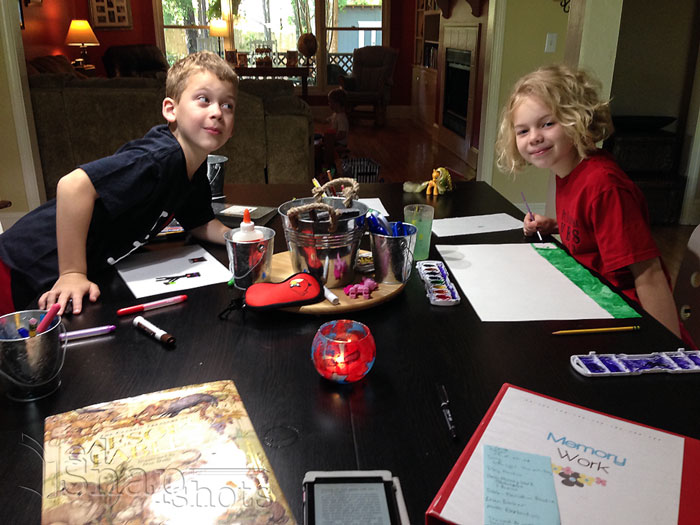
There are good school days and there are bad ones. Homeschooling is a bit like Forrest Gump’s box of chocolates — sometimes it is difficult to predict on any given morning which kind of day you are going to get.
If I have to choose a common element in all of our good homeschool mornings (besides everyone getting enough sleep) it would be that those good days invariably start with the practice we call Morning Time.
Morning Time, Circle Time, Morning Basket, Morning Meeting — these terms are often used interchangeably. These are all used by homeschoolers to name what I describe as Morning Time, yet these terms are also sometimes used to describe more progressive or utilitarian practices which are not the same at all.
So let’s take a look at the origin and characteristics of Morning Time and try to develop a concise picture of what it is.
Morning Time is the brainchild of Cindy Rollins. For over 25 years her family has started each day gathered around mom reading, singing, discussing and living what has become their Morning Time.
Once Cindy began writing and speaking about the practice, it became popular among Classical and Charlotte Mason homeschoolers as they recognized the value in spending time each day reading aloud from living books and learning in community.
Most recently, Morning Time has gained more widespread popularity in the homeschooling community with its inclusion in Sarah Mackenzie’s book as a key strategy for Teaching from Rest.
Quite simply, Morning Time contains subjects that the family can do together that emphasize truth, goodness, and beauty in their homeschool. Morning Time is a liturgy — one part of Charlotte Mason’s “atmosphere” of education.
These small practices done daily over time are not only a means to an education (and a good one at that), but a means to shaping virtue in ourselves and in our children.
While Morning Time will look slightly different in every family, there are some characteristics that are common across every Morning Time. Let’s talk a look at these common characteristics — the 3Rs, if you will, of Morning Time:
1. Ritual
One of the main characteristics of Morning Time is the inclusion of ritual. Ritual elevates mundane, ordinary activities into something that has meaning beyond the sum total of those activities. Why does this matter? After all, aren’t we just teaching history and science?
We are also teaching persons. We are striving to create in our children life-long seekers of knowledge by building habits and virtue. In doing so education needs to be more than a means to an end, but instead an act practiced with importance.
Morning Time allows you to start your day placing an almost reverent importance on the act of acquiring knowledge.
If your house is anything like mine there isn’t much reverence —potty humor and couch Olympics are likely to break out at any time. This is the very reason why adding ritual to Morning Time is important. How can this be done?
Actually it is surprisingly easy. The consistent daily habit of Morning Time itself is just one way. Simply by getting up and doing it day in and day out you are emphasizing the importance of education.
Some families will begin each Morning Time with prayer, singing, or the reading of a Psalm. Each morning session could also begin by lighting a candle or the recitation of a favorite family poem.
Cindy ends her Morning Time with the Doxology and a blessing — “The Lord be with you,” to which her children respond “And also with you.” This simple benediction is a ritual as well.
2. Reading
The heart of Morning Time is the things you choose to read aloud to your children. These may differ from family to family but will characteristically include the best stories from children’s and classic literature.
While all family members may have their own reading at other times of day, reading during Morning Time is done in community which leads to the opportunity for shared discussion.
Choose selections that will appeal to the age-range of your children. If you have mostly younger children then quality picture books, a story Bible written in beautiful language, fairy tales and Lamb’s or Nesbit’s Shakespeare are wonderful choices.
Older elementary children and teens should experience Scripture from your preferred translation and Shakespeare from the original. Don’t worry. They can and do understand it.
If you have a wide age range then read books aimed towards the older children first while everyone is fresh and attention is high. Little ones can play (hopefully — this takes some training depending on their ages) with toys while you read.
Later in Morning Time the older children can be dismissed to complete independent work and you can take the little ones aside to enjoy stories that will appeal more to their attention span.
The beauty of this family reading program is that with practice, the entire family, from oldest to youngest, will grow in appreciation of beautiful stories and language.
It never ceases to amaze my husband that all three of my children yell, “Ooo Shakespeare!” as if they are greeting a long-lost friend whenever his name is mentioned.
3. Recitation
The final common characteristic of Morning Time is the inclusion of recitation or memorization. Because our character is shaped by the words we hide within our heart, recitation is a valuable method of education in the homeschool.
As with every other Morning Time practice, families will approach this differently. Scripture, poetry, prayers (in English and Latin), and Shakespeare are all worthy additions to a Morning Time recitation list. Some families will choose to memorize more, others may limit themselves to Scripture or poetry.
Some families will add practical tidbits such as a history timeline and math facts to this list. For ideas about what to memorize, this list of 100 Things for Kids to Memorize will get you started.
While memorization can be as simple as shared reciting while reading, you can also add additional techniques to your Morning Time practices to aid in memory work. My kids like to use songs, funny voices, and even review games to spice up our recitation practice.
Other Subjects
While these 3Rs are the basics of Morning Time, the possibility for adding subjects to your Morning Time is limitless. The main requirement is that these are subjects your children will be doing as a group — either as an entire family or as select group of the siblings (i.e. younger kids or older kids).
Some subjects you might add include: hymn study, nature study, reading for history or science, artist or picture study, composer study, music appreciation, English grammar or sentence diagramming and simple handicrafts.
Right now in our Morning Time we are including line practice for a play we are participating in, the exploration of multiplication through hands-on activities, and narration training using Aesop’s Fables, as I want my kids to learn to narrate for their other studies next year. These things work for us.
- Which Homeschool Schedule Actually Works for You? - June 3, 2025
- How to Keep Homeschool Consistent When Life Isn’t - May 20, 2025
- Six Smart Questions to Ask Before You Buy Curriculum - May 6, 2025



